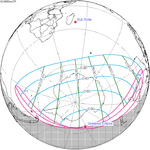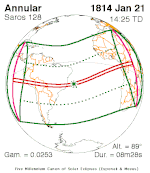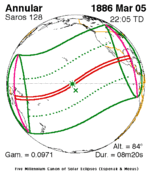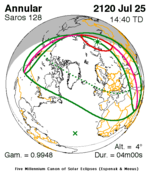An annular solar eclipse will occur at the Moon's descending node of orbit on Tuesday, June 22, 2066, with a magnitude of 0.9435. A solar eclipse occurs when the Moon passes between Earth and the Sun, thereby totally or partly obscuring the image of the Sun for a viewer on Earth. An annular solar eclipse occurs when the Moon's apparent diameter is smaller than the Sun's, blocking most of the Sun's light and causing the Sun to look like an annulus (ring). An annular eclipse appears as a partial eclipse over a region of the Earth thousands of kilometres wide.
Related eclipses
Eclipses in 2066
- A total lunar eclipse on January 11, 2066.
- An annular solar eclipse on June 22, 2066.
- A partial lunar eclipse on July 7, 2066.
- A total solar eclipse on December 17, 2066.
- A penumbral lunar eclipse on December 31, 2066.
Metonic
- Preceded by: Solar eclipse of September 3, 2062
- Followed by: Solar eclipse of April 11, 2070
Tzolkinex
- Preceded by: Solar eclipse of May 11, 2059
- Followed by: Solar eclipse of August 3, 2073
Half-Saros
- Preceded by: Lunar eclipse of June 17, 2057
- Followed by: Lunar eclipse of June 28, 2075
Tritos
- Preceded by: Solar eclipse of July 24, 2055
- Followed by: Solar eclipse of May 22, 2077
Solar Saros 128
- Preceded by: Solar eclipse of June 11, 2048
- Followed by: Solar eclipse of July 3, 2084
Inex
- Preceded by: Solar eclipse of July 13, 2037
- Followed by: Solar eclipse of June 2, 2095
Triad
- Preceded by: Solar eclipse of August 22, 1979
- Followed by: Solar eclipse of April 23, 2153
Solar eclipses of 2065–2069
This eclipse is a member of a semester series. An eclipse in a semester series of solar eclipses repeats approximately every 177 days and 4 hours (a semester) at alternating nodes of the Moon's orbit.[1]
| Solar eclipse series sets from 2065 to 2069 | ||||
|---|---|---|---|---|
| Descending node | Ascending node | |||
| 118 | July 3, 2065 Partial |
123 | December 27, 2065 Partial | |
| 128 | June 22, 2066 Annular |
133 | December 17, 2066 Total | |
| 138 | June 11, 2067 Annular |
143 | December 6, 2067 Hybrid | |
| 148 | May 31, 2068 Total |
153 | November 24, 2068 Partial | |
| 158 | May 20, 2069 Partial | |||
Saros 128
This eclipse is a part of Saros series 128, repeating every 18 years, 11 days, and containing 73 events. The series started with a partial solar eclipse on August 29, 984 AD. It contains total eclipses from May 16, 1417 through June 18, 1471; hybrid eclipses from June 28, 1489 through July 31, 1543; and annular eclipses from August 11, 1561 through July 25, 2120. The series ends at member 73 as a partial eclipse on November 1, 2282. Its eclipses are tabulated in three columns; every third eclipse in the same column is one exeligmos apart, so they all cast shadows over approximately the same parts of the Earth.
The longest duration of totality was produced by member 27 at 1 minutes, 45 seconds on June 7, 1453, and the longest duration of annularity was produced by member 48 at 8 minutes, 35 seconds on February 1, 1832. All eclipses in this series occur at the Moon’s descending node of orbit.[2]
| Series members 47–68 occur between 1801 and 2200: | ||
|---|---|---|
| 47 | 48 | 49 |
 January 21, 1814 |
 February 1, 1832 |
 February 12, 1850 |
| 50 | 51 | 52 |
 February 23, 1868 |
 March 5, 1886 |
 March 17, 1904 |
| 53 | 54 | 55 |
 March 28, 1922 |
 April 7, 1940 |
 April 19, 1958 |
| 56 | 57 | 58 |
 April 29, 1976 |
 May 10, 1994 |
 May 20, 2012 |
| 59 | 60 | 61 |
 June 1, 2030 |
 June 11, 2048 |
 June 22, 2066 |
| 62 | 63 | 64 |
 July 3, 2084 |
 July 15, 2102 |
 July 25, 2120 |
| 65 | 66 | 67 |
 August 5, 2138 |
 August 16, 2156 |
 August 27, 2174 |
| 68 | ||
 September 6, 2192 | ||
External links
- Earth visibility chart and eclipse statistics Eclipse Predictions by Fred Espenak, NASA/GSFC
- ^ van Gent, R.H. "Solar- and Lunar-Eclipse Predictions from Antiquity to the Present". A Catalogue of Eclipse Cycles. Utrecht University. Retrieved 6 October 2018.
- ^ "NASA - Catalog of Solar Eclipses of Saros 128". eclipse.gsfc.nasa.gov.





Recent Comments